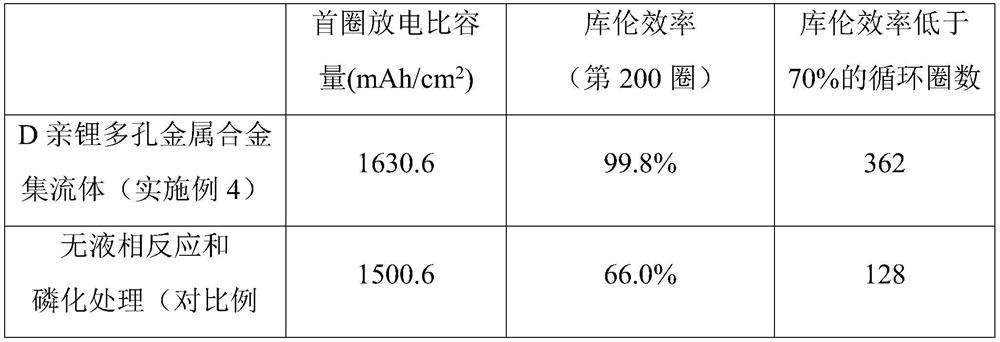3D lithium-philic composite porous metal alloy current collector, and preparation method and application thereof
A technology of porous metals and metal alloys, which is applied in the coating process of metal materials, lithium batteries, electrode carriers/collectors, etc., can solve the problems of unstable lithium-philic layer structure, non-conductive lithium products, large volume effect, etc., to achieve Improved Coulombic efficiency and cycle stability, uniform deposition/dissolution, and enhanced diffusion effects
- Summary
- Abstract
- Description
- Claims
- Application Information
AI Technical Summary
Problems solved by technology
Method used
Image
Examples
Embodiment 1
[0047] Phosphorus copper mesh (Cu-Sn alloy) with a metal alloy fiber diameter of 5 μm, a porosity of 50%, a thickness of 60 μm, and a mass of 0.6 g was added to a mixture of 3M NaOH solution and 0.5 mmol / L ammonium persulfate solution. The solution was reacted at room temperature for 45min, cleaned and dried, placed in a tube furnace with an argon flow downwind direction, 3g of sodium hypophosphite was placed in the upwind direction, heated to 300°C at a rate of 2°C / min, and the air flow was 150ml Phosphate for 2h under argon flow / min.
[0048] The experimental results found that the metal fibers of the prepared materials were uniformly coated with a layer of Cu. 3 P-Sn 3 P 2 Nanolayers and their surface nanowires, Cu 3 P-Sn 3 P 2 The thickness of the nanolayer is 100 nm, Cu 3 P-Sn 3 P 2 The length of the nanowires is 8 μm, Cu 3 P-Sn 3 P 2 The content is 40wt.%.
Embodiment 2
[0050] A brass mesh (Cu-Zn alloy) with a metal alloy fiber diameter of 10 μm, a porosity of 60%, a thickness of 120 μm, and a mass of 1.0 g was added to a mixed solution composed of 4M NaOH solution and 1.0 mmol / L hydrogen peroxide solution. Reaction at room temperature for 90min, cleaned and dried, placed in a tube furnace in the downwind direction of argon flow, placed 4g of sodium hypophosphite in the upwind direction, heated to 400°C at a rate of 2°C / min, and heated to 400°C at a rate of 2°C / min. Phosphate for 3h.
[0051] The experimental results found that the metal fibers of the prepared materials were uniformly coated with a layer of Cu. 3 P-Zn 3 P 2 Nanolayers and their surface nanowires, Cu 3 P-Ti 3 P 2 The thickness of the nanolayer is 150 nm, Cu 3 P-Ti 3 P 2 The length of the nanowires is 8 μm, Cu 3 P-Ti 3 P 2 The content is 60wt.%.
Embodiment 3
[0053] A silver-copper mesh (Cu-Ag alloy) with a metal alloy fiber diameter of 30 μm, a porosity of 50%, a thickness of 200 μm, and a mass of 2.5 g was added to 5M NaOH solution and 3.0 mmol / L potassium permanganate solution. The mixed solution was reacted at room temperature for 90min, cleaned and dried, placed in a tube furnace with an argon flow downwind direction, 10g of sodium hypophosphite was placed in the upwind direction, heated to 500°C at a rate of 5°C / min, and heated to 500°C at a rate of 5°C / min. Phosphate under argon flow for 4h.
[0054] The experimental results found that the metal fibers of the prepared materials were uniformly coated with a layer of Cu. 3 P-Ag 3 P nanolayers and their surface nanowires, Cu 3 P-Ag 3 P 2 The thickness of the nanolayer is 180 nm, Cu 3 P-Ag 3 P 2 The length of the nanowire is 12 μm, Cu 3 P-Ag 3 P 2 The content is 80wt.%.
PUM
| Property | Measurement | Unit |
|---|---|---|
| Thickness | aaaaa | aaaaa |
| Length | aaaaa | aaaaa |
| Thickness | aaaaa | aaaaa |
Abstract
Description
Claims
Application Information
 Login to view more
Login to view more - R&D Engineer
- R&D Manager
- IP Professional
- Industry Leading Data Capabilities
- Powerful AI technology
- Patent DNA Extraction
Browse by: Latest US Patents, China's latest patents, Technical Efficacy Thesaurus, Application Domain, Technology Topic.
© 2024 PatSnap. All rights reserved.Legal|Privacy policy|Modern Slavery Act Transparency Statement|Sitemap



